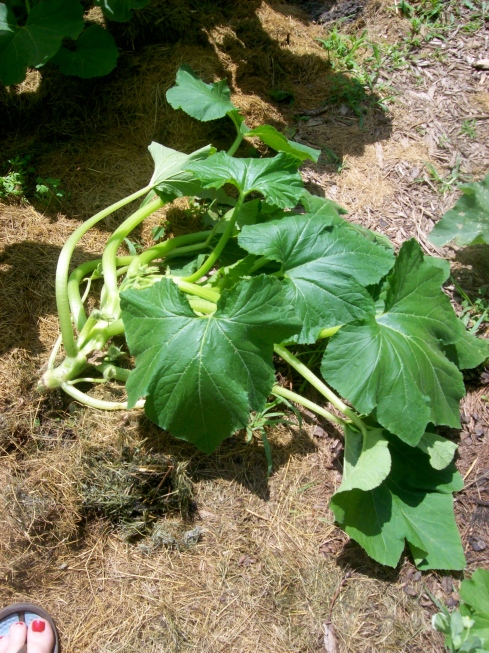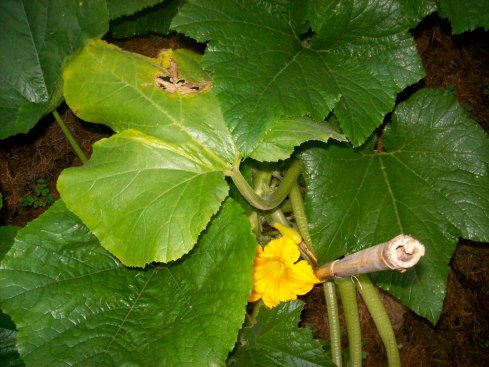Twice last week I went out to my garden in the morning to find that huge and healthy zucchini plants had toppled over during the night. There were no signs of forced entry through my garden fence anywhere at all. Thorough autopsies revealed no insect infestations and no sudden fungal attacks. What happened?
I went to bed one night with the squash looking like this:

. . . only to find this the next morning:

The first time this happened, I thought I might have unwittingly knocked it over myself the night before, because the toppled plant was on the outside end of its row, nearest the garden path. The second time this happened, two plants were down, one on each end of the row. And I knew that I had been nowhere near the zucchini plant nearest the fence the night before.
At this rate, I knew I had to take action if I wanted to have any zucchini to harvest before summer’s end. A search of the Internet revealed that I am hardly alone with this problem. And, after asking my more veteran gardener sister, it looks as if this runs in the family as well. Summer squash vines can get so heavy that they just snap from their own weight.
So what do you do to prevent further damage? The consensus is to put additional dirt over the vulnerable place on the stem where the others have broken off. One gardener said that if the break is not clean, a plant may be salvaged if the plant puts new roots down around the stem.
So I’m giving that a try. The broken vine nearest the path could not be salvaged because it was on this plant that I conducted my hasty post mortems But the broken zucchini plant near the fence had a fighting chance, so I did indeed cover the broken spot with more soil. I also strategically put a stake in the ground between a leaf stem and the vine to help stabilize the plant. This was several days ago. Today it looks as if my zucchini vine may recover:

A couple of the leaves look as if they may die, but the rest of the plant appears to be thriving. A zucchini has formed and more blossoms have opened since taking this approach.
This appears to be a problem only with summer squash and not winter squash. I spent the better part of an afternoon going from plant to plant, inspecting each stem for possible damage. I found initial cracks on two yellow squash. I covered these stems — well, all of the summer squash stems — with additional soil to encourage more root growth and to provide more support. Hopefully, this will prevent further losses in the future. And, in the place of the two that I lost, new seeds have been planted. No harm in staggering the harvest, I guess.
Zucchini is supposed to be one of the simplest vegetables to grow, and as a newbie, this was one I thought I had a pretty good chance of seeing success. Wish me luck.

2 comments
Comments feed for this article
July 10, 2009 at 5:27 am
Tina
Hmmm, that was interesting. Looks like somethings will always remain mystery.
I myself have been trying to solve the mystery of this legend for a while now. Could not understand much though.
Let me know in case you get to understand the mystery of the Old Hound and the Legend
By the way, good writing style. I’d love to read more on similar topics
July 10, 2009 at 3:57 pm
@jeanannvk
Hi there,
Amanda and I chatted about your squash problem on our Good Enough Gardening podcast…will be posted on Monday! 🙂